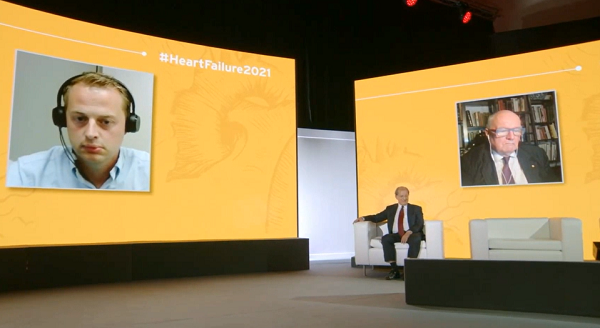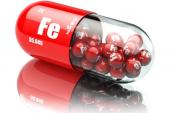IRON-CRT: IV Iron Boosts LVEF, Cardiac Contractility in Deficient HF Patients
The trial was small and focused on documenting a mechanistic link, but it further supports a role for ferric carboxymaltose.

Treatment of iron deficiency in patients with heart failure and reduced ejection fraction (HFrEF) at least 6 months after implantation with a cardiac resynchronization therapy (CRT) device can improve cardiac function on top of other guideline-recommended care, the small IRON-CRT trial shows.
And importantly, ferric carboxymaltose (FCM) supplementation also appeared to improve cardiac contractility, providing a glimpse of the mechanism by which improving iron stores may help to reverse cardiac remodeling. Pieter Martens, MD, PhD (Ziekenhuis Oost Limburg, Genk, Belgium), presented the trial results this week at the virtual European Society of Cardiology (ESC) 2021 Heart Failure Congress.
Iron supplementation is already recommended by both the 2016 European (IIa) and 2017 US guidelines (Class IIb) to improve heart failure symptoms, exercise capacity, and quality of life. The largest study to date, AFFIRM-AHF, released at last year’s American Heart Association meeting, missed its primary endpoint (total hospitalizations and cardiovascular death) but did demonstrate a significant 26% drop in total HF hospitalizations with iron supplementation. That secondary finding is expected to help strengthen the recommendations for iron in future guidelines—the new European HF guidance will be released at the main ESC Congress later this summer.
However, as Marten stressed during his presentation, mechanistic details on how supplementation is of benefit and whether it has any direct impact on cardiac structure and function has been lacking.
The IRON-CRT results were simultaneously published in the European Heart Journal.
Functional Endpoints
IRON-CRT enrolled 75 patients with iron deficiency and reduced ejection fraction, despite being on optimal medical therapy and a CRT device for at least 6 months, then randomized them to FCM or placebo.
At 3 months, improvement in LVEF (the primary endpoint) was significantly greater in the FMC group, although both groups improved (+4.22% vs +3.05%, P < 0.001). Similarly, LV end-systolic volume (but not LV end-diastolic volume) also was improved in the FCM group.
During his presentation, Marten explained that one of the reasons for enrolling patients with CRT was that patients with iron deficiency have been shown in prior studies to derive less benefit from CRT. But by restricting the study to participants who already had these devices implanted, the IRON-CRT investigators could also use pacing protocols and recordings to meticulously measure changes in the force-frequency relationship—a measure of cardiac performance that gauges the ability of the heart to respond appropriately to increased effort—by plotting invasively measured contractility against heart rate. At 3 months, said Martens, the negative force frequency seen in all patients at baseline (the cardiac contractility index decreased at higher heart rates) became positive among those receiving iron supplementation, whereas no such change was seen among those not randomized to iron.
On top of prior studies, these latest mechanistic data are “really showing that this is a unique target: that iron deficiency contributes to poor pump function, and that if we treat it we are able to improve it and we're probably able to improve the contractility of the heart,” Martens explained to TCTMD. “And this also gives us at least part of the explanation why those patients improve in functionality and maximal exercise capacity.”
Following Martens presentation, session moderator and ESC Heart Failure Association President Petar M. Seferović, MD, PhD (Belgrade University Medical Center, Serbia), agreed. “Not only the results of your study, but also the design of your study, are very attractive and are providing some new insight into how FCM may work,” he said. “I think that [FCM] is here to stay.”
For me, [FCM] is an add-on. It's like giving a bit of fertilizers to your plants during the spring and autumn, giving a little boost. Nathan Mewton
Nathan Mewton, MD, PhD (Hôpital Cardio-Vasculaire Louis Pradel, Lyon, France), commenting on the results for TCTMD, also called out the very rigorous, mechanistic quality of the study—something this group is known for, he said.
“Alone, this trial doesn't have any value, but in light of all the evidence now that is surrounding ferric carboxymaltose supplementation, it all goes in the same direction,” Mewton said. “There is a pathophysiologic rationale, because iron is necessary for the muscles and for the heart, so there is a direct link to pathophysiology. But this [issue] doesn't concern the whole HF population, only those who have a deficit.” That number is hard to pin down, he added, but it’s usually estimated at less than 50% of the total heart failure population.
That said, he continued, this trial is consistent with the other randomized, double-blind studies “showing that [FCM] can improve functional capacity, and that’s something that’s important in patients with low ejection fraction, and this study looked at that very precisely.”
Impact on Patients, Guidelines
All of the patients in IRON-CRT were on maximal guideline-recommended therapies (including 50% on an angiotensin receptor-neprilysin inhibitor) as recommended at the time the trial was launched, although more have since come onto the market, Martens stressed during his talk. And while the trial specifically focused on patients whose LV function did not improve despite 6 months of CRT, the authors note in the EHJ that there is “no reason to believe” that iron supplementation wouldn’t also lead to gains in HFrEF patients with iron deficiency who lack an implanted device.
Moreover, Martens explained to TCTMD, it’s well established that patients with iron deficiency don’t respond as well to CRT as those with normal iron levels—the amount of gains in LV function seen here appear to close that gap.
As for whether these data, along with AFFIRM-AHF, will be enough to bump up the recommendations for iron supplementation in heart failure, Martens pointed out that positive results from a large, randomized clinical trial are usually what’s needed for a class I indication. AFFIRM-AHF was greeted enthusiastically but missed its primary endpoint. As such, the currently class IIa/b recommendations may be “fair,” he said.
“But in the future there are still many morbidity/mortality trials in stable heart failure coming out and if they also show positive results, then I think the level of evidence will probably increase to a IIa or IIb indication,” he predicted.
He also made the point that FCM therapy would be complimentary to other established and emerging heart failure drugs, not an alternative. It has the advantage of being, for many patients, a one-time infusion, perhaps once a year, as opposed to a daily pill. But the logistics of getting all eligible patients into infusion clinics or other models, given the sheer number of eligible patients, would itself be a challenge. “So there are some hurdles to implementing this,” he acknowledged, including the costs of establishing infusion programs.
Some insights into cost were provided during a second late-breaking clinical trial session, on Wednesday, where Phil McEwan, PhD (Swansea University, Wales), presented a cost-efficacy analysis from AFFIRM-AHF trial. Using four different countries’ healthcare systems, McEwan showed that FCM supplementation was associated with modest but clinically meaningful quality-adjusted life-year gains, at a cost that was either cost-saving or cost-effective. In all four settings, cost offsets were attributable to the predicted reduction in resource utilization associated with reductions in heart failure hospitalizations.
To TCTMD, Mewton expressed a note of caution about these kinds of analyses when the primary trial results were null, as was seen with AFFIRM-AHF.
Mewton, too, said he doesn’t put FCM on par with other evidence-based therapies, given the fact that it is not a daily medication and only useful in patients with demonstrated iron deficiency. “For me, it's an add-on,” he said. “It's like giving a bit of fertilizers to your plants during the spring and autumn, giving a little boost.”
Shelley Wood is the Editor-in-Chief of TCTMD and the Editorial Director at CRF. She did her undergraduate degree at McGill…
Read Full BioSources
Martens P, Dupont M, Dauw J, et al. The effect of intravenous ferric carboxymaltose on cardiac reverse remodelling following cardiac resynchronization therapy—the IRON-CRT trial. Eur Heart J. 2021;Epub ahead of print.
McEwan P. AFFIRM-AHF-based multinational cost-effectiveness analysis of intravenous ferric carboxymaltose for the treatment of iron deficiency in an acute heart failure setting. Presented at: ESC Heart Failure 2021. June 29, 2021.
Disclosures
- Martens reports receiving consultancy fees, speaker fees, travel grants, and an unrestricted research grant from Vifor Pharma.
- McEwan reports research support from Vifor Pharma.




Comments